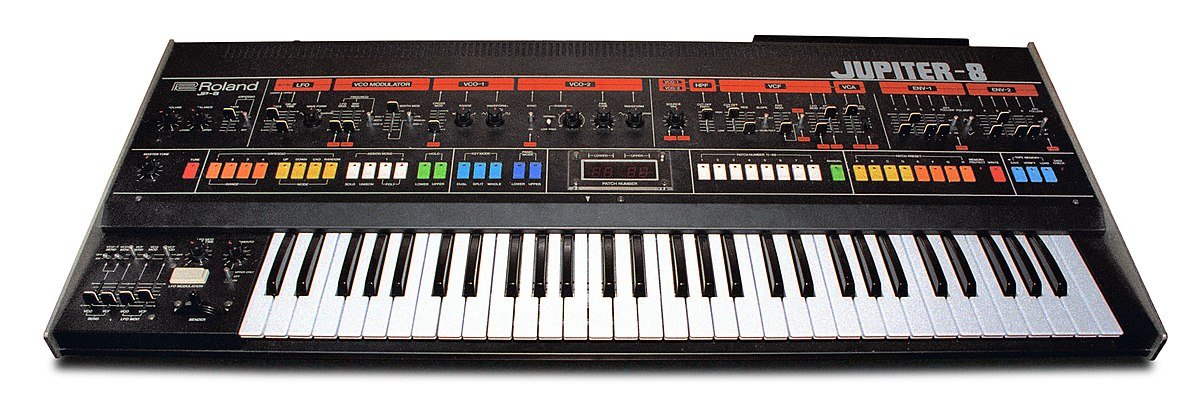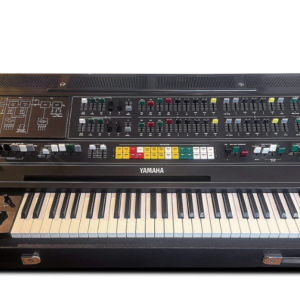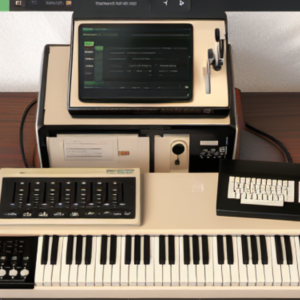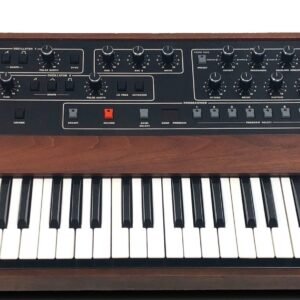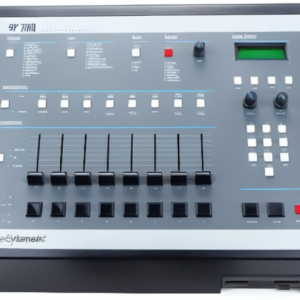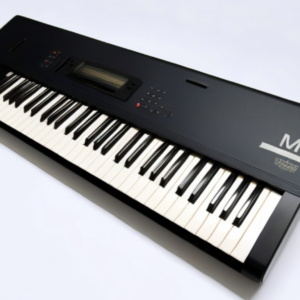Roland Jupiter 8
The Roland Jupiter-8 stands as a cornerstone in the realm of analog synthesizers, embodying the epitome of lush, polyphonic sound synthesis. Introduced in 1981, amidst the golden era of analog synthesis, the Jupiter-8 swiftly became revered for its unparalleled sonic capabilities and intuitive user interface. Its release marked a significant milestone in Roland’s legacy, solidifying the company’s position as a pioneering force in electronic musical instrument innovation.
At its core, the Jupiter-8 represents a convergence of cutting-edge technology and artistic expression. Crafted during a time when analog synthesis was at its zenith, this iconic instrument captured the essence of musical experimentation and sonic exploration. Its robust architecture, coupled with a rich array of features, empowered musicians to sculpt a diverse range of sounds, from ethereal pads to piercing leads, with unparalleled depth and expressiveness.
With its distinctive sound and versatile functionality, the Jupiter-8 quickly garnered attention from top-tier artists and producers across various genres. From pop anthems to cinematic soundscapes, the Jupiter-8 left an indelible mark on the landscape of contemporary music, shaping the sonic identity of countless recordings and performances.
Beyond its technical prowess, the Jupiter-8 holds a special place in the hearts of synth enthusiasts and collectors alike. Its sleek design, featuring a distinctive control panel adorned with glowing sliders and buttons, exudes a timeless elegance that continues to captivate audiences decades after its initial release.
As we delve deeper into the exploration of the Roland Jupiter-8, we uncover not just a synthesizer, but a symbol of innovation, creativity, and sonic mastery. In the following sections, we will delve into the design and features of this legendary instrument, unraveling the secrets behind its enduring legacy in the world of electronic music.
Design and Features
The Roland Jupiter-8’s design exemplifies a harmonious blend of form and function, embodying both elegance and practicality. Its sleek and timeless aesthetic, characterized by a minimalist layout and sturdy construction, remains an enduring symbol of classic synth design.
At the heart of the Jupiter-8 lies a powerful analog signal path, comprised of 16 oscillators, 8 voices, and a wealth of modulation options. This formidable architecture allows for the creation of complex, layered sounds with unparalleled depth and richness. Each voice is equipped with two oscillators, offering a wide range of waveform options including sawtooth, square, pulse, and noise, allowing for intricate sound sculpting.
One of the standout features of the Jupiter-8 is its innovative voice assign mode, which enables users to explore a variety of playing techniques and performance styles. Whether it’s monophonic, polyphonic, unison, or dual mode, the Jupiter-8 adapts effortlessly to the musician’s creative vision, providing a seamless and intuitive playing experience.
The instrument’s interface is thoughtfully designed, with a comprehensive array of controls laid out in a logical and ergonomic manner. The front panel boasts an array of sliders, knobs, and buttons, each offering direct access to a specific parameter or function. This intuitive layout encourages experimentation and exploration, allowing users to quickly dial in their desired sound without getting lost in a maze of menus or submenus.
In addition to its sound-shaping capabilities, the Jupiter-8 features a built-in arpeggiator and chord memory function, further expanding its sonic palette and performance possibilities. These innovative features add a dynamic and rhythmic dimension to the instrument, opening up new avenues for musical expression and creativity.
From its robust construction to its intuitive user interface, the Roland Jupiter-8 embodies the pinnacle of analog synthesizer design. Its timeless appeal and versatile functionality continue to captivate musicians and producers alike, cementing its status as a true icon in the world of electronic music.
Sound Generation
The Roland Jupiter-8’s sound generation capabilities are the cornerstone of its legendary status in the realm of analog synthesizers. Built upon a foundation of rich, organic analog circuitry, the Jupiter-8 delivers a sonic palette that is both expansive and sonically captivating.
At the heart of the Jupiter-8’s sound generation are its two voltage-controlled oscillators (VCOs) per voice, each offering a wide range of waveform options. These oscillators produce classic analog waveforms such as sawtooth, square, pulse, and noise, allowing for the creation of a diverse array of sounds ranging from warm, lush pads to biting lead lines.
One of the defining characteristics of the Jupiter-8’s sound is its unmistakable analog warmth and character. The oscillators exhibit a rich, organic quality that is often described as “fat” or “juicy,” adding depth and texture to every note played. This inherent warmth, coupled with the instrument’s wide range of modulation options, allows for the creation of complex, evolving sounds that are full of life and expression.
The Jupiter-8’s flexible filter section further enhances its sonic capabilities, offering a choice between low-pass, high-pass, and band-pass filter modes. The 24dB per octave analog filters provide smooth, musical resonance and are capable of sculpting sounds with precision and finesse. From silky-smooth filter sweeps to aggressive, biting resonance, the Jupiter-8’s filter section adds a powerful dimension to its sonic palette.
In addition to its oscillators and filters, the Jupiter-8 features a comprehensive modulation matrix that allows for intricate sound manipulation and animation. With multiple envelope generators, LFOs, and modulation routings, users can create dynamic, evolving patches that respond to the nuances of their playing style.
Whether it’s soaring leads, lush pads, or funky basslines, the Roland Jupiter-8 excels at bringing musical ideas to life with its unparalleled sound generation capabilities. Its rich, analog sound and intuitive interface continue to inspire musicians and producers around the world, cementing its legacy as one of the most iconic synthesizers of all time.
Notable Users and Influences
The Roland Jupiter-8 has left an indelible mark on the world of music, shaping the sonic landscape of countless recordings and performances across a diverse range of genres. From pop anthems to experimental electronica, the Jupiter-8’s distinctive sound has found its way into the hands of some of the most influential artists and producers in the industry.
One notable user of the Jupiter-8 is legendary composer and producer, Brian Eno. Renowned for his pioneering work in ambient music, Eno utilized the Jupiter-8 to craft ethereal soundscapes and otherworldly textures that have become synonymous with his signature style. Tracks such as “An Ending (Ascent)” from his album “Apollo: Atmospheres and Soundtracks” showcase the Jupiter-8’s ability to create immersive, otherworldly soundscapes that transport listeners to distant realms.
In the realm of pop music, the Jupiter-8 has been a staple in the arsenal of numerous chart-topping artists and bands. From the iconic synth stabs in Duran Duran’s “Rio” to the lush pads in Madonna’s “Lucky Star,” the Jupiter-8’s versatile sound has helped define the sound of the ’80s and beyond. Artists like Prince, Michael Jackson, and Depeche Mode also relied on the Jupiter-8 to add depth and texture to their hit songs, further cementing its status as a pop culture icon.
In the realm of electronic music, the Jupiter-8’s influence can be felt across a wide spectrum of genres, from techno and house to ambient and experimental. Artists like Jean-Michel Jarre, Kraftwerk, and Tangerine Dream embraced the Jupiter-8’s lush, analog sound to create immersive soundscapes and pulsating rhythms that pushed the boundaries of electronic music.
Beyond its impact on individual artists, the Jupiter-8’s influence extends to the broader landscape of music production and synthesis. Its iconic sound and intuitive interface have inspired countless musicians and producers to explore new sonic territories and push the limits of creativity.
In conclusion, the Roland Jupiter-8’s legacy is not just confined to its technical specifications or design features; it lives on through the music it has helped create and the artists it has inspired. From its humble beginnings in the early ’80s to its continued relevance in the digital age, the Jupiter-8 remains a symbol of innovation, creativity, and sonic mastery.
Impact and Legacy
The impact of the Roland Jupiter-8 on the world of music cannot be overstated. From its introduction in 1981 to the present day, this iconic synthesizer has left an indelible mark on the landscape of electronic music, shaping the sonic identities of countless recordings and performances across genres.
One of the key aspects of the Jupiter-8’s legacy is its role in popularizing analog synthesis during the 1980s. At a time when digital technology was on the rise, the Jupiter-8 stood out for its rich, organic sound and intuitive interface, helping to preserve and elevate the art of analog synthesis in an increasingly digital world. Its influence can be heard in a wide range of musical genres, from pop and rock to electronic and experimental, where its warm, lush tones have become synonymous with classic ’80s sound.
The Jupiter-8’s impact extends beyond its sonic capabilities to its role as a cultural icon. Its sleek design and distinctive control panel have made it a sought-after collector’s item, prized not only for its musical qualities but also for its aesthetic appeal. Countless musicians, producers, and synth enthusiasts around the world continue to cherish and celebrate the Jupiter-8 as a symbol of innovation, creativity, and sonic exploration.
Moreover, the Jupiter-8’s legacy lives on through its influence on subsequent generations of synthesizers and electronic music production tools. Many of the features and design elements introduced in the Jupiter-8 have become standard fare in modern synthesizers, underscoring its enduring relevance and impact on the evolution of electronic music technology.
In the realm of performance and live music, the Jupiter-8’s reputation as a powerhouse synthesizer continues to attract musicians seeking its legendary sound and versatility. Its presence on stage and in the studio serves as a testament to its enduring appeal and status as a go-to instrument for professionals and enthusiasts alike.
In conclusion, the Roland Jupiter-8’s impact and legacy are woven deeply into the fabric of electronic music history. As a pioneering synthesizer that helped shape the sound of an era and inspire generations of musicians, its influence reverberates far beyond its technical specifications, leaving an enduring legacy that continues to resonate with artists and audiences around the world.
Collector's Value and Market Trends
The Roland Jupiter-8 holds a special place in the hearts of synth enthusiasts and collectors, making it a highly sought-after instrument on the vintage market. Its iconic design, legendary sound, and historical significance contribute to its enduring popularity and collector’s value.
Over the years, the market for vintage synthesizers, including the Jupiter-8, has experienced significant growth, driven by a combination of nostalgia, appreciation for analog sound, and the desire for authentic vintage gear. As a result, prices for well-maintained Jupiter-8s have steadily increased, with pristine examples commanding premium prices in the collector’s market.
Factors such as the condition, age, and rarity of the Jupiter-8 can significantly influence its value in the collector’s market. Instruments that have been meticulously maintained, with all original components intact and functioning properly, are typically valued higher than those that show signs of wear or modification. Limited edition or early production models may also fetch higher prices due to their rarity and historical significance.
In addition to individual sales, the Jupiter-8 is often featured in auctions and specialty vintage synth marketplaces, where enthusiasts and collectors gather to buy, sell, and trade iconic instruments. These platforms provide opportunities for both seasoned collectors and newcomers to acquire rare and coveted synthesizers like the Jupiter-8, albeit at premium prices reflective of their collector’s value.
As with any collectible item, market trends and demand for the Jupiter-8 can fluctuate over time, influenced by factors such as supply, demand, and broader economic conditions. However, the enduring appeal of the Jupiter-8 as a symbol of innovation and sonic excellence ensures that it remains a highly desirable and valuable instrument for collectors and musicians alike.
In conclusion, the Roland Jupiter-8’s collector’s value and market trends reflect its status as a timeless icon in the world of vintage synthesizers. As demand for vintage gear continues to grow, the Jupiter-8 stands out as a prized possession for collectors and a cherished instrument for musicians seeking its legendary sound and legacy.
Innovations and Contributions
The Roland Jupiter-8 stands as a testament to Roland’s commitment to innovation and excellence in the realm of synthesizer technology. Throughout its illustrious history, the Jupiter-8 has introduced several groundbreaking innovations and made significant contributions to the evolution of electronic music.
One of the key innovations of the Jupiter-8 lies in its architecture and design. Featuring 16 analog oscillators, 8 voices, and a comprehensive array of modulation options, the Jupiter-8 represented a quantum leap forward in polyphonic synthesizer technology when it was introduced in 1981. Its powerful sound engine and intuitive interface set new standards for analog synthesis, inspiring generations of musicians and shaping the sonic landscape of the ’80s and beyond.
Another notable innovation of the Jupiter-8 is its voice assign mode, which allows users to dynamically assign voices in monophonic, polyphonic, unison, or dual mode, depending on their performance needs. This flexibility in voice allocation opened up new possibilities for expressive playing and creative sound design, empowering musicians to explore a wide range of playing techniques and performance styles.
Additionally, the Jupiter-8’s built-in arpeggiator and chord memory function introduced innovative ways to sequence and manipulate sounds in real-time, adding a dynamic and rhythmic dimension to its sonic palette. These features, combined with its robust modulation matrix and flexible filter section, gave rise to a wealth of creative possibilities and helped redefine the role of synthesizers in contemporary music production.
Beyond its technical innovations, the Jupiter-8 has made significant contributions to the cultural and musical landscape, shaping the sound of numerous recordings and performances across genres. Its lush, analog sound and intuitive interface have inspired countless musicians and producers to push the boundaries of creativity and sonic experimentation, leaving an indelible mark on the history of electronic music.
In conclusion, the Roland Jupiter-8’s legacy of innovation and contributions extends far beyond its technical specifications or design features. As a pioneering synthesizer that helped define an era and inspire generations of musicians, its influence resonates deeply in the world of electronic music and continues to shape the future of synthesis and sound design.
Community and Support
The Roland Jupiter-8 has fostered a vibrant and dedicated community of enthusiasts, musicians, and synthesizer aficionados who share a passion for its iconic sound and timeless design. This community serves as a hub for sharing knowledge, exchanging ideas, and celebrating the legacy of this legendary instrument.
One of the primary avenues for community engagement and support is online forums and discussion groups dedicated to vintage synthesizers and electronic music production. These forums provide a platform for Jupiter-8 owners and enthusiasts to connect with like-minded individuals, ask questions, and share experiences related to their beloved instrument. Discussions range from technical troubleshooting and repair tips to patch programming and performance techniques, fostering a sense of camaraderie and mutual support among members.
In addition to online forums, social media platforms such as Facebook, Instagram, and Twitter play a vital role in connecting Jupiter-8 enthusiasts around the world. Dedicated groups and pages devoted to vintage synthesizers provide a space for sharing photos, videos, and stories related to the Jupiter-8, allowing members to showcase their setups, discuss favorite patches, and connect with fellow fans of analog synthesis.
Beyond the digital realm, the Jupiter-8 community also thrives through in-person events, meetups, and gatherings organized by local synth enthusiasts and vintage gear enthusiasts. These events offer opportunities for Jupiter-8 owners to network, collaborate, and showcase their music in a supportive and welcoming environment, fostering a sense of community and belonging among participants.
Furthermore, Roland’s commitment to customer support ensures that Jupiter-8 owners have access to resources and assistance to help them get the most out of their instrument. Whether it’s technical support, software updates, or user manuals, Roland’s customer service team is dedicated to ensuring that Jupiter-8 owners have the tools and information they need to enjoy a seamless and rewarding musical experience.
In conclusion, the Roland Jupiter-8’s vibrant community and robust support network play a crucial role in preserving its legacy and fostering a sense of connection among enthusiasts and musicians. From online forums and social media groups to in-person events and Roland’s customer support services, the Jupiter-8 community continues to thrive, united by a shared love for this iconic synthesizer and the music it inspires.
Conclusion
The Roland Jupiter-8 stands as a timeless icon in the world of synthesizers, revered for its legendary sound, innovative design, and enduring legacy. From its introduction in 1981 to the present day, the Jupiter-8 has captivated musicians, producers, and enthusiasts alike with its lush, analog sound and intuitive interface.
Throughout its illustrious history, the Jupiter-8 has made significant contributions to the evolution of electronic music, shaping the sonic landscape of the ’80s and beyond. Its powerful sound engine, flexible architecture, and innovative features have inspired countless musicians to push the boundaries of creativity and sonic exploration, leaving an indelible mark on the history of synthesis and sound design.
Moreover, the Jupiter-8’s cultural impact extends beyond its technical specifications, fostering a vibrant community of enthusiasts and supporters who share a passion for its timeless sound and design. From online forums and social media groups to in-person events and Roland’s customer support services, the Jupiter-8 community continues to thrive, united by a shared love for this iconic instrument and the music it inspires.
As we reflect on the legacy of the Roland Jupiter-8, it becomes clear that its influence transcends mere technology; it embodies the spirit of innovation, creativity, and sonic mastery that continues to resonate with musicians and enthusiasts around the world. Whether it’s on stage, in the studio, or in the hands of a dedicated collector, the Jupiter-8 remains a symbol of excellence and inspiration, embodying the limitless possibilities of analog synthesis and the enduring power of music to move and inspire us.
